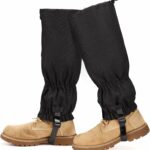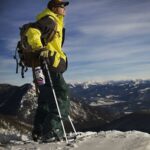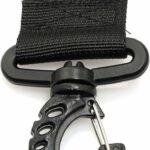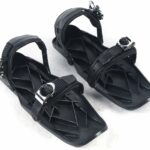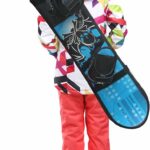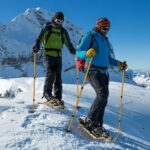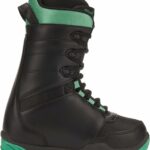You’ve seen them in stores, perhaps even watched others use them, and you may be wondering when to use snowshoes. They’re not just for extreme mountain climbing or life-saving emergencies. Snowshoes are perfect for many outdoor winter activities. Imagine crisp, snowy landscapes that seem untouched, like something out of a picture book. With a pair of snowshoes, you can experience nature without crowds in peaceful solitude. But when exactly is the best time to strap these on? This article aims to clear the snow off this query, enlightening you on the prime conditions and situations where your trusty snowshoes can come in real handy.
Understanding Snowshoes
Snowshoeing is a fun, accessible, and an excellent way to experience the great outdoors in winter. Whether you’re contemplating your first pair of snowshoes or curious about the sport, let’s dive into understanding more about snowshoes.
Definition of snowshoes
Snowshoes are specialized footwear designed for walking or hiking over snow. They work by distributing your weight over a larger area so you don’t sink into the snow, a concept called ‘flotation.’ They look like oversized, somewhat oval-shaped mini tennis rackets you fasten on your boots.
History and evolution of snowshoes
Snowshoes have been around for thousands of years, with archeological evidence suggesting they may have been used as early as 4000 BC. Indigenous peoples in cold, snowy regions originally developed them as essential tools for survival. Over time, snowshoes evolved from rawhide and wooden frames to modern materials like lightweight metal, plastic, and synthetic fabrics. The design also evolved from the classic ‘teardrop’ shape to more specialized designs tailored to different activities and terrains.
Types of snowshoes and their features
There are three main types of snowshoes: recreational, backcountry, and running snowshoes. Recreational snowshoes are for beginners and casual enthusiasts embarking on groomed trails or packed snow. Backcountry snowshoes are designed for more challenging terrain, with features like aggressive crampons for grip and heel lifts for climbing steep slopes. Running snowshoes, the lightest of all, are for snow races or training during the winter. They feature a more streamlined design for better speed and maneuverability.
Basics of Snowshoeing
Snowshoeing may seem daunting at first, but after you understand the basics, you’ll realize it’s a sport that almost anyone can enjoy.
How to wear snowshoes
To wear snowshoes, first align your boots in the bindings, ensuring your toes don’t touch the fronts on the shoes. The straps or buckles should cradle your midfoot and ankle. You might be holding poles, too – they provide balance and alleviate some pressure from your legs.
Walking techniques in snowshoes
Walking in snowshoes isn’t much different from regular walking, but you do need to lift your feet a bit higher and stride wider to avoid stepping on the frames. While ascending, lean forward and step using your toe crampons for traction. When descending, lean back slightly and step with your heels first. If you’re traversing a slope, keep your uphill shoe above your downhill shoe to avoid sliding.
Safety measures in snowshoeing
Safety is paramount in snowshoeing. Always check the weather and avalanche forecasts, and don’t venture into risky areas unless you’re trained and equipped. Dress in moisture-wicking layers, wear sun protection, and bring a pack with essentials like food, water, map, compass, headlamp, first aid kit, and a whistle.
When to Use Snowshoes
Snowshoes aren’t just for deep snow. They can benefit in various snow conditions and situations.
Effects of snow depth and density
Generally, the deeper the snow, the more necessary are snowshoes. They provide necessary flotation, avoiding the exhausting “post-holing” — when you sink into the snow with every step. Snow density also matters; even if the snow isn’t deep, fluffy, light snow often requires snowshoes, whereas you may not need them on dense, hard-packed snow.
Situations that require snowshoes
You’d use snowshoes in any scenario where footing on snow is challenging or energy-consuming. They’re essential for winter hiking, backcountry skiing or snowboarding, hunting, trapping, ice fishing and, in some cases, for winter survival.
Benefits of using snowshoes in the snow
Beyond just making it physically feasible to travel over snow, snowshoes also offer safety benefits. The metal crampons beneath snowshoes provide traction, helping prevent slips or falls on slippery surfaces. They also conserve your energy by preventing you from sinking excessively into the snow.
Snowshoeing in Different Weather Conditions
Each type of snow presents its own challenges and experience – and it’s within these differences that snowshoeing reveals its greatness.
Snowshoeing in fresh snow
Snowshoeing in fresh, fluffy snow is typically where it shines. There’s no feeling quite like being the first to trek through a pristine terrain.
Snowshoeing in hard-packed snow
When the snow is hard packed, you might not need as much flotation, but snowshoes still provide needed traction. Smaller snowshoes can be used in such conditions for better maneuverability.
Snowshoeing in icy conditions
In icy conditions, please rely on the snowshoe’s crampons for traction. However, be wary of ice layers that can cause you to slide regardless of your footwear.
Snowshoeing in Different Terrains
The beauty of snowshoeing lies in its versatility. Let’s look at snowshoeing across various terrains.
Snowshoeing in flat terrains
Flat terrains, like parks and groomed trails, are perfect for beginners. They require less energy and technique, allowing you to focus on mastering the basics.
Snowshoeing in hilly or mountainous terrains
Snowshoeing in hilly or mountainous terrains are for the more adventurous and physically fit. It requires more energy and technique, especially ascending and descending slopes. Choose snowshoes with climbing features like heel lifts for such terrains.
Snowshoeing in forests or wilderness
Forests and wilderness provide the enchantment of seclusion and beauty, but also challenges like deep snow, navigation difficulties, and a more significant risk factor. Always stay safe and prepared.
Snowshoeing for Different Purposes
Snowshoeing is versatile beyond different terrains and weather; it also serves a multitude of purposes.
Snowshoeing for recreation or exercise
Recreational snowshoeing is a great low-impact, aerobic exercise. It allows you to burn calories while enjoying the wintry splendor – an excellent change of scenery from your regular fitness regime.
Snowshoeing for hunting or trapping
Hunters and trappers use snowshoes to access remote areas and quietly approach game in the winter. Snowshoes don’t leave as much of a trail, making it easier to stay undetected.
Snowshoeing for winter camping or survival
Snowshoes can be crucial for winter camping, helping campers reach their site or gather firewood efficiently. In survival situations, snowshoes can mean the difference between getting stranded or reaching safety.
Choosing the Right Snowshoes
Choosing the right snowshoes substantially impacts your comfort and experience in the snow. Here’s what you should consider.
Size and design considerations
Your weight, including your gear, determines the size of your snowshoes; more weight requires more flotation. The terrain also affects the design – you’d want a more compact, rounded shape for maneuverability in forests, and you’d go for a longer, pointed design for open, rolling terrains.
Material and construction considerations
Modern snowshoes are mostly made of lightweight, durable materials like aluminum, synthetic fabrics, and plastic. The bindings should be comfortable, easy to adjust, and secure. The crampons should be stainless steel for durability and traction.
Brand and price considerations
Although brand isn’t everything, reputable companies tend to produce reliable snowshoes. You can find quality snowshoes in various price ranges; cheaper ones would suffice for casual use, while more expensive ones provide superior comfort and features for heavy and technical use.
Care and Maintenance of Snowshoes
Proper care and maintenance will keep your snowshoes in good shape, potentially saving you from trouble down the line.
Cleaning and drying snowshoes
Clean your snowshoes after each use by brushing off snow and dirt, and wash them with mild soap if necessary. Ensure they’re thoroughly dry before storing to prevent damage from moisture or mold.
Repairing damaged snowshoes
For minor damage, most manufacturers sell parts like replacement straps or crampons. A professional should handle more major damages or repairs.
Storing snowshoes properly
Store your snowshoes in a cool, dry place away from direct sunlight. Make sure they’re not under any heavy objects that could deform their shape.
Common Mistakes in Using Snowshoes
Avoid these common mistakes that new snowshoers often make.
Ignoring weather and snow forecasts
Always check the weather and snow conditions before heading out. It’s not worth risking your safety for a day out in the snow.
Not adjusting snowshoes properly
Wearing improperly adjusted snowshoes can lead to discomfort and blisters. Take your time to correctly adjust your bindings, making sure your boots are centered and secure.
Not practicing enough with snowshoes
Snowshoeing is easy to pick up, but it still requires practice, particularly on different terrains and inclines. The more you wear your snowshoes, the more comfortable and efficient you’ll become.
Getting Professional Training in Snowshoeing
While you can teach yourself snowshoeing, professional training can enhance your skills and safety.
Benefits of formal training
Formal training equips you with the proper techniques, safety protocols, and navigation skills. It can also provide training in rescue techniques and avalanche awareness – things you hope you’ll never have to use, but could save your life.
Finding snowshoeing classes or workshops
Many outdoor organizations and parks offer snowshoeing classes and workshops. You could also check with local outdoor stores for leads or recommendations.
Learning from experienced snowshoers or guides
Experienced snowshoers or guides can be a wealth of knowledge. Don’t be afraid to ask for advice or learn from their experiences, as they most likely have been in your shoes (or snowshoes, in this case) before.
In conclusion, snowshoeing is a fantastic way to embrace winter: it’s accessible, versatile, and genuinely delightful. Whether for leisure, exercise, or utilitarian purposes, snowshoeing offers a unique perspective on the beauty of winter. As with any venture into the wild, it’s crucial to be mindful of safety measures and be adequately prepared. Now that you’re more familiar with snowshoes and snowshoeing, all you need is a touch of curiosity and a dash of adventure – and you’re ready to embark on your snowshoeing journey!
- What Snowboard Bindings Should I Get? - January 23, 2024
- What Size Screws For Snowboard Bindings? - January 23, 2024
- How To Snowmobile On Water? - January 23, 2024

